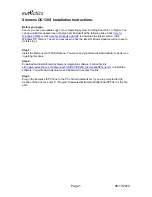
154
EPICenter Concepts and Solutions Guide
Policy Manager Overview
specification. For example, if you specify policy endpoints as 10.2.0.0/16, 10.2.0.1, and 10.2.0.25, the
Policy Manager will use only 10.2.0.0/16
The IP QoS rules generated from EPICenter IP policy definitions are also known as Access List rules,
because they define and control IP-based access between endpoints. A rule implementing IP-based QoS
between server A and client B effectively defines the access allowed between those two endpoints.
Access rules intended to permit access between the endpoints are implemented using one of the QoS
profiles (QP1 through QP4 or QP8) that allow access, within the bandwidth and priority constraints
defined by the QoS profile. An access rule intended to deny access from one endpoint to another is
implemented in the EPICenter Policy Manager using the “blackhole” QoS profile.
IP-based QoS policies (or Access List policies) are supported on Extreme devices running ExtremeWare
5.0 or later— all
i
-series devices, and non-
i
-series devices running ExtremeWare 5.0x. This means that all
devices in the scope for an IP policy must be running ExtremeWare 5.0 or later.
Source Port Policies
A Source Port policy identifies traffic originating from a specific port on an Extreme switch, and assigns
that traffic to a QoS profile. In the policy definition, you specify as endpoints the specific ingress ports
from which the traffic will originate. As shown in Figure 69, a source port policy is always
uni-directional and implements Source Port QoS on the traffic flow from the specified source port.
Figure 69: Source Port policy
You can specify multiple source ports in a single policy, and you can specify them by providing
higher-level resources such as a host name, user name, or a group, as long as the resources can be
mapped by the Policy Manager to a port on a switch. If you specify a group, only the resources within
the group (and its subgroups) that map to source ports will be used as policy endpoints.
In the case of source port QoS, the endpoint specification and the scope are theoretically redundant,
because the endpoint specification effectively defines the scope of the policy. However, you must specify
both the endpoint and the policy scope. If there are devices in the policy scope (for example, when the
scope resource is a group) that are not related to the ports specified as endpoints. These will not be
affected by the source port policy definition. For more details, see “Policy Access Domain and Scope”
on page 159.
Unlike IP QoS, a Source Port QoS rule is implemented only on the device where the source port resides.
However, you can enforce QoS throughout the network using 802.1Q tagging—specifically by explicit
packet marking using 802.1p or DiffServ. If the switch ports used for output use 802.1Q tagging, the
QoS profile assignment will be carried via the 802.1p priority bits to the next switch. On
i
-series chipset
devices, you can also enable DiffServ examination and replacement to observe and carry the QoS setting
with the packet between switches. The use of 802.1p priority bits is enabled when you enable tagging,
XM_018
Server
Policy scope
IP address
QP2
QP2
(802.1p tag)
Содержание EPICenter 5.0
Страница 12: ...12 EPICenter Concepts and Solutions Guide Preface...
Страница 76: ...76 EPICenter Concepts and Solutions Guide Managing your Network Assets...
Страница 92: ...92 EPICenter Concepts and Solutions Guide Managing VLANs...
Страница 116: ...116 EPICenter Concepts and Solutions Guide Managing Wireless Networks...
Страница 146: ...146 EPICenter Concepts and Solutions Guide VoIP and EPICenter Avaya Integrated Management...
Страница 163: ...Appendices...
Страница 164: ......
Страница 178: ...178 EPICenter Concepts and Solutions Guide Troubleshooting...
















































